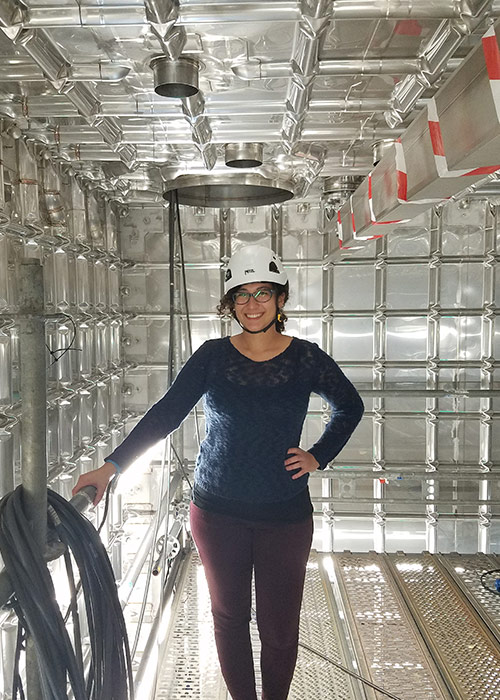Physics Graduate Student Spends Month at CERN
Working on a Prototype for the Deep Underground Neutrino Experiment
For a physicist, working at CERN, the European Organization for Nuclear Research, ranks as one of the best possible ways to spend a summer. Casandra Morris, a graduate student in physics at the University of Houston, got to do just that, spending a month at CERN as part of her involvement in an international physics collaboration.
DUNE: the Deep Underground Neutrino Experiment
 Casandra Morris, graduate student in physics, standing inside a prototype detector
for the Deep Underground Neutrino Experiment.Morris’ task while at CERN?
Casandra Morris, graduate student in physics, standing inside a prototype detector
for the Deep Underground Neutrino Experiment.Morris’ task while at CERN?
Working on a prototype detector for the Deep Underground Neutrino Experiment (DUNE), an international collaboration of more than 1,000 scientists from 30 different countries, brought together in a goal of answering questions about the nature of matter and the evolution of the universe.
“Being a part of an experiment that is still early in its development, doing hands-on work, was exciting and satisfying,” said Morris, who received her bachelor’s degree in physics from UH’s College of Natural Sciences and Mathematics in 2015. Morris conducts her research under the direction of associate professor of physics Lisa Whitehead Koerner.
Capturing Neutrino Reactions
To accomplish these goals, DUNE is constructing detectors to catch elusive particles called neutrinos. Although our universe is pervaded with neutrinos, their tiny mass, at most one-millionth that of an electron, and lack of charge make them extraordinarily hard to detect.
Detecting neutrinos requires looking for the very rare reaction of a neutrino with a proton, in this case those within an argon atom, which creates charged particles.
To capture these reactions, DUNE will shoot a beam of neutrinos 800 miles through the earth, from the Fermi National Accelerator Laboratory in Illinois, to detectors in Lead, South Dakota. Already, the excavations in South Dakota have begun, where eventually four detectors, containing a total of 68,000 tons of pure liquid argon, will sit 5,000 feet below ground.
Building a Detector Prototype
Before these detectors are built, scientists need to test out prototypes, to ensure the design will function as planned. At CERN, a team of scientists, including Morris, are constructing a prototype detector, at a one-twentieth scale, which will be ready for testing by the end of 2018.
“Our prototype fits in a warehouse, whereas we are excavating a gold mine for the actual detector,” Morris said. “We are testing out the design.”
Morris’ particular area of expertise is cold electronics. When a detector contains liquid argon that has been cooled to -184°C, constructing the electronic system becomes its own challenge. When interactions are that rare, filtering out noise also becomes critical.
“Our design is testing out ways to reduce noise,” Morris said. “Noise can be caused by the length of the wires you are using, radiation from the walls of the detector, or even other experiments that are going on nearby. Placing the electronics that read the signal from electrons directly into the argon reduces the length of the wires needed, thus reducing noise.”
- Rachel Fairbank, College of Natural Sciences and Mathematics
October 17, 2017